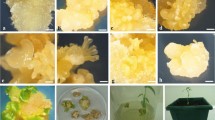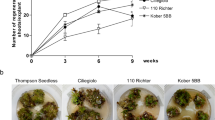Summary
Production of transgenic plants is gradually becoming routine in cassava biotechnology. Green cotyledons of maturing somatic embryos (somatic cotyledons for short) and friable embryogenic suspensions (FES) are the target tissues for transformation by Agrobacterium or biolistics. Putative transgenic shoots develop from transformed somatic cotyledons via shoot organogenesis or from FES via somatic embryogenesis under selection. Maturation of transgenic somatic embryos is induced by transfer to maturation medium with reduced concentrations of selective agents. Mature somatic embryos can also develop directly from FES cells under selection. Transgenic plants are regenerated by the elongation of transgenic shootlets from organogenesis experiments and by the germination of or shoot development from transgenic mature embryos cultured without selection. β-Glucuronidase (GUS) assays and rooting tests can be used to screen for escapes from selection, which improves the regeneration rate of truly transgenic plants.
Access this chapter
Tax calculation will be finalised at checkout
Purchases are for personal use only
Similar content being viewed by others
References
Stamp, J. A. and Henshaw, G. G. (1987) Somatic embryogenesis from clonal leaf tissue of cassava. Ann. Bot. 59, 445–450.
Mathews, H., Schopke, C., Carcamo, R., Chavarroaga, P., Fauquet, C., and Beachy R. N. (1993) Improvement of somatic embryogenesis and plant recovery in cassava. Plant Cell Rep. 12, 328–333.
Li, H. Q., Huang, Y. W., Liang, C. Y., and Guo, J. Y. (1995) Improvement of plant regeneration from cyclic somatic embryos in cassava, in Cassava Biotechnology Network (Ed.) Proc. Second Int. Scientific Meeting, Bogor, Indonesia, CIAT Working Document 150, pp. 289–302.
Taylor, N. J., Edwards, M., Kiernan, R. J., Davey, C. D. M., Blakesley, D., and Henshaw G. G. (1996) Development of friable embryogenic callus and embryogenic suspension culture systems in cassava (Manihot esculenta Crantz). Nat. Biotech. 14, 726–730.
Li, H. Q., Huang, Y. W., Liang, C. Y., et al. (1998) Regeneration of cassava plants via shoot organogenesis. Plant Cell Rep. 17, 410–414.
Zhang, P., Phansiri, S., and Puonti-Kaerlas, J. (2001) Improvement of cassava shoot organogenesis by the use of silver nitrate in vitro. Plant Cell Tiss. Org. Cult. 67, 47–54.
Li, H. Q., Sautter, C., Potrykus, I., and Puonti-Kaerlas, J. (1996) Genetic transformation of cassava (Manihot esculenta Crantz). Nat. Biotech. 14, 736–740.
Zhang, P., Legris, G., Coulin, P., and Puonti-Kaerlas, J. (2000) Production of stably transformed cassava plants via particle bombardment. Plant Cell Rep. 19, 939–945.
Zhang, P., Potrykus, I., and Puonti-Kaerlas, J. (2000) Efficient production of transgenic cassava using negative and positive selection. Transgenic Res. 9, 405–415.
Schöpke, C., Taylor, N., Carcamo, R., et al. (1996) Regeneration of transgenic cassava plants (Manihot esculenta Crantz) from microbombarded embryogenic suspension cultures. Nat. Biotech. 14, 731–735.
González, A. E., Schöpke, C., Taylor, N. J., Beachy, R. N., and Fauquet, C. M. (1998) Regeneration of transgenic cassava plants (Manihot esculenta Crantz) through Agrobacterium-mediated transformation of embryogenic suspension cultures. Plant Cell Rep. 17, 827–831.
Zhang, P. and Puonti-Kaerlas, J. (2000) PIG-mediated cassava transformation using positive and negative selection. Plant Cell Rep. 19, 1041–1048.
Raemakers, K. C. J. M., Schreuder, M., Pereira, I., Munyikwa, T. R. I., Jacobsen, E., and Visser, R. G. F. (2001) Progress made in FEC transformation of cassava. Euphytica 120, 15–24.
Munyikwa, T. R. I., Raemakers, K. C. J. M., Schreuder, M., et al. (1998) Pinpointing towards improved transformation and regeneration of cassava (Manihot esculenta Crantz). Plant Sci. 135, 87–101.
Murashige, T. and Skoog, F. (1962) A revised medium for rapid growth and bioassays with tobacco tissue cultures. Physiol. Plant. 15, 473–497.
Schenk, R. U. and Hildebrandt, A. C. (1972) Medium and techniques for induction and growth of monocotyledonous and dicotyledonous plant cell cultures. Can. J. Bot. 50, 199–204.
Gresshoff, P. and Doy, C. (1974) Derivation of a haploid cell line from Vitis vinifera and the importance of the stage of meiotic development of the anthers for haploid culture of this and other genera. Z. Pflanzenphys. 73, 132–141.
Hoekema, A., Hirsch, P. R., Hooykaas, P. J. J., and Schilperoort, R. A. (1983) A binary plant vector strategy based on separation of vir-and T-region of the Agrobacterium tumefaciens Ti-plasmid. Nature 303, 179–180.
Jefferson R. A. (1987) Assaying chimeric genes in plants: the GUS gene fusion system. Plant Mol. Biol. Rep. 5, 387–405.
Author information
Authors and Affiliations
Editor information
Editors and Affiliations
Rights and permissions
Copyright information
© 2005 Humana Press Inc.
About this protocol
Cite this protocol
Zhang, P., Puonti-Kaerlas, J. (2005). Regeneration of Transgenic Cassava From Transformed Embryogenic Tissues. In: Peña, L. (eds) Transgenic Plants: Methods and Protocols. Methods in Molecular Biology™, vol 286. Humana Press. https://doi.org/10.1385/1-59259-827-7:165
Download citation
DOI: https://doi.org/10.1385/1-59259-827-7:165
Publisher Name: Humana Press
Print ISBN: 978-1-58829-263-6
Online ISBN: 978-1-59259-827-4
eBook Packages: Springer Protocols




